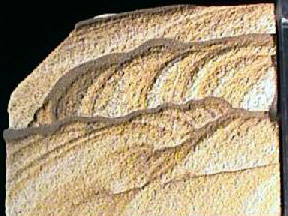Sandstone is a very common sedimentary rock and perhaps the best known sedimentary rock. It is formed in many environments. Just about anywhere there is water, whether frozen or not, in a river or ocean, there is a chance to form sandstone. Even where there is no water as in a desert, there is sandstone formation under foot. The grains are important to geologists and so are the minerals that cement them together. Sandstone cements can influence the durability, color, porosity and usefulness of the stone. Normal cementing agents include calcite, quartz (silica), clays and gypsum. Silica cemented sandstone is very durable and hard. Calcite cemented sandstone is subject to acidic dissolution and is more easily eroded. Clay and gypsum cements, which are soft minerals, tend to produce much softer sandstone and the sand can sometimes be rubbed off in a person's hands. The cementing agents also affect the porosity of a sandstone. When the initial sand is first deposited there are lots of open spaces or pores. Water, for instance, flows right through sand due to all the pores. But as the sand turns into rock, the cement can fill in these pores making the sandstone less porous and less able to allow water to move through the rock. Generally sandstone is a very porous rock as rocks go and will have substantial pore spaces. Sandstone is the ideal rock for ground water and will house substantial aquifers. Petroleum also is a fluid that flows through sandstone and sandstone is also the best oil reservoir. Iron oxides, manganese oxides and other impurities can cause bright and contrasting colors in sandstones. These colors are what gives sandstone its unique character and ornamental desirability. The colors range from bright whites, reds, yellows, oranges and even purples and greens. Colored sandstone is usually intricately banded in multiple colors which enhance its aesthetic appeal. Sandstone's banding is due to layers of sand that are deposited with differing characteristics. Sandstone is formed in many deposits that are episodic in nature and the resulting layers can be very different from previous layers. Sometimes the sand is courser or finer than the previous layer and this difference causes the banding. Dunes and ripples of sand can cut across earlier deposits and cut off those earlier bands with bands of their new. This results in a texture call cross-bedding (see picture above) and can be very intricate and interesting. "Picture Rock" is a type of ornamental sandstone that can display scenic, almost picture like banding. Sandstone deposits can be a beautiful part of the natural environment and apart of the breath-taking views at many natural parks and preserves. The sandstone deposits of the the Grand Canyon, Zion, Bryce, Mesa Verde, Arches, and Red Rock National Parks to name a few in just the USA provide millions of visitors spectacular views. Mined sandstone can be cut, polished and carved for many uses. It is used as ornamental rocks for buildings, monuments, grave stones, bookends, beverage coasters, tiles and many other possible uses. Sandstone can also provide silica for glass production. Some mineral ores are found in sandstone. Uranium can concentrate in uranium minerals in sandstone deposits and many uranium ore bodies are the result. Heavy minerals such as rutile, gold, diamonds and others can be found in sandstones from prehistoric placer deposits that are now worked for their economic value. |
 The Rock - Sandstone
The Rock - Sandstone